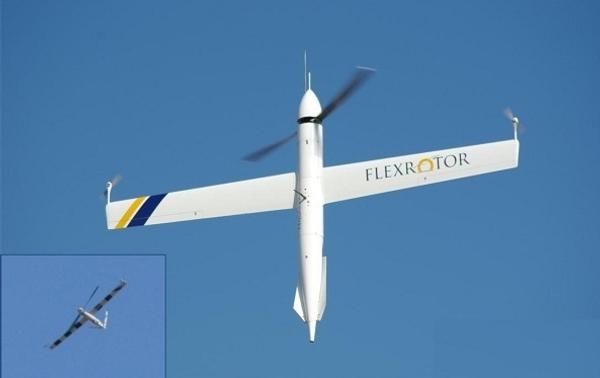Mon, Aug 22, 2011
Aircraft Designed To Be Autonomous In The Air And On The
Ground
Transition between hover and wing-borne cruise has been
demonstrated by Aerovel's Flexrotor UAV ... capabilities which
allow it to combine VTOL with range of more than 1,600 nm and
endurance exceeding a day and a half. Aerovel's president, Tad
McGeer, explains that "transition requires a climb, pitch-over,
dive, and zoom, so we entered the new regime with a roller-coaster
thrill. But after a few seconds the ride turns sedate, with the
engine ticking over for long-endurance cruise at 50-60 kt, and the
big rotor hardly making a sound."

Flexrotor's first wing-borne flight included autopilot and
performance checks, followed by transition back to hover. The
technique, says McGeer, "involves a 3g pull-up from 70 kt to
nose-vertical, climbing over 100 metres in about 3 seconds. The
autopilot managed the transition maneuvers nicely, and was crisp
and precise in both wing- and thrust-borne regimes." Pandora then
hovered into a docking station, which is itself a key component of
the Flexrotor system.
McGeer explains that "Flexrotor is designed to be autonomous not
only in the air, but also on the ground. We've designed a rig which
assembles in a few minutes out of a duffel bag, and then handles
the aircraft automatically through the full cycle of launch,
retrieval, docking, fueling, checkout, and back to launch." The rig
uses a pair of widely-spaced parallel bars to support the wings,
which McGeer says "offers a practical, forgiving target for use on
something like a small boat on a windswept sea."
The overall objective, says McGeer, is "to make operating costs low
enough for civil applications, such as offshore weather
reconnaissance and geological survey. We aim to get there through
small size, long range, light footprint, basing flexibility, and
autonomy throughout the operations cycle."
More News
Also: Netherlands Donates 18 F16s, 2 737s Collide On Ramp, E-7 Wedgetail Cut, AgEagle's 100th In S Korea The Pilot and Aircraft Privacy Act was introduced in the House by Represent>[...]
Pilot Also Reported That Due To A Fuel Leak, The Auxiliary Fuel Tanks Were Not Used On June 4, 2025, at 13:41 eastern daylight time, a Piper PA-23, N2109P, was substantially damage>[...]
Have A Story That NEEDS To Be Featured On Aero-News? Here’s How To Submit A Story To Our Team Some of the greatest new stories ANN has ever covered have been submitted by our>[...]
From 2023 (YouTube Edition): Reflections on War’s Collective Lessons and Cyclical Nature The exigencies of war ought be colorblind. Inane social-constructs the likes of racis>[...]
What Goes Around, May Yet Come Back Around, Klyde FMI: www.klydemorris.com>[...]
 Airborne 06.30.25: US v ADS-B Misuse, Natl STOL Fire, Volocopter Resumes
Airborne 06.30.25: US v ADS-B Misuse, Natl STOL Fire, Volocopter Resumes NTSB Prelim: Piper PA-23
NTSB Prelim: Piper PA-23 ANN FAQ: Submit a News Story!
ANN FAQ: Submit a News Story! Classic Aero-TV: One Mans Vietnam
Classic Aero-TV: One Mans Vietnam Klyde Morris (06.30.25)
Klyde Morris (06.30.25)



